
|
|
|
_________________
|
Our
flight to the jump zone was uneventful with us sitting along each side of the
aircraft, each one appearing to be looking at his feet, in an attempt to hide
the fear of the moment displayed on each face. Occasionally in catching one�s
eye we would give each other a thumbs up gesture. It�s amazing how this little
contact could ease the strain of the moment.
Our
flight took us over the Owen Stanley Mountains. It grew extremely cold, lips
started turning blue, looking around at the faces of the jumpers, they looked
like aliens, pale white, blue lips, chin strap pulled tightly across the chin to
hold the helmet in place and wearing the mask of the unknown fear we were about
to experience.
Word
came to stand up and hook up, and each man stood and fastened his static line to
the cable in the plane. We checked our own gear, and the gear of the man in
front. The plane lost altitude for the jump, and at 500 feet the go
signal was given. Out the plane we went.
|
|
Our landing site was a field of ten foot high kunai grass. It was extremely dusty from the dried out grass of years gone by, its saw-tooth edges cutting. The temperature had to be 120 degrees, and we soon found that the only way to get to the edge of this mess was to fall forward, let the next man walk over you, and then for him to fall and you in turn walk over him. Many of our troops passed out in the heat and had to be carried to the shelter of the jungle.
After
regrouping patrols were sent out to collect as many natives as possible and get
the kunai grass cut to create an airstrip. Security was set up around the field,
and an Australian battery of 25 pounder (equivalent to the us 75mm Howitzers) was dropped to give us support fire
power. The thirty-four Aussies jumping with their cannon had never made a jump before, but in
the tradition of the Aussie to prove his manliness, guns and men came out of the
planes like professional jumpers.
Meanwhile,
back on the field, things were progressing nicely. One native, who was the
Number One Boy (this being his definition of his title) kept the other natives
working. He had some knowledge of English, having worked for an English banana
grower. It was a joy to hear him giving orders in Pidgin-English. His definition
of a P-38 Fighter was "Big Bird with twin ass."
He referred to his employer on the banana plantation as "Boss
Man" and the employer's wife as "Missy." In Pidgin-English he
told us he always carried Missy when they went anywhere, when asked Why? He
stated "No get Missy ass wet."
With
the completion of the air strip, the Australian Division came in and the
operation was turned over to them. Loading on the planes that brought the
Aussies in, we were flown back to Port Moresby and from there to our previous
camp site. Things went back to normal, taking Atabrine tablets to ward off
malaria and getting medicinal shots and being inspected for hernias. (Bend over
and spread your cheeks.)
Ordinance crews were brought in. Guns were inspected and repaired to as-new condition. End Markham Valley.
Our
dress was boots and GI shorts, which allowed the tropical sun to tan and the
Atabrine tablets to yellow our bodies. Without clothes we looked Oriental. It
was during this stay in camp that I tasted Kick A Poo Joy Juice, another name
given it was Jungle Juice. The stuff smelled and tasted awful, but was supposed
to have an alcohol content, but this I doubt. The concoction was made up from
stolen canned fruit from the Mess Hall (apples, peaches prunes and mixed fruits)
poured into a five gallon gas can and hidden for several weeks, to allow it to
ferment. After fermentation we strained it through a clean sock and
drank it. The strained debris in the sock was full of the strangest insects
imaginable, nonetheless it was relished as though it were a good Scotch Whisky.
It
was during our stay at this camp that we learned of the death of our Commander,
and the takeover by Col. Jones. If
my memory serves me correctly, we moved from this camp back to Australia,
spending several weeks at Brisbane. The troops were given the freedom to roam
the town, in an effort to relieve their anxieties. My initial excursion was to
find a good meal, and with the help of a taxi driver, locate the Zoo. Having
found the Zoo to be within walking distance of our camp I spent each day
enjoying the varied animals, and the fish in the Aquarium. In a large open air
bird cage containing a variety of different birds I found a Cockatoo that could
speak a few words. He or she would walk around the railing inside the cage, and
when approached would cock it's head to one side and say "Scratch
Cocky." I found this to be quite amusing and decided to see if I could get
it to say other words. Being the Devil I am I started repeating "Scratch
Cocky's ass" each time he would say �Scratch Cocky�, and on the third
day he said it, and kept on saying it each time someone approached him. Well,
the men that heard it laughed aloud, but the women were shocked, especially if
they had youngsters.
I
spent the better part of my free time sitting on the grass back from the cage
enjoying the reaction of the people who heard the bird say "Scratch Cocky's
Ass."
Well,
our short stay at Brisbane suddenly came to an end. We loaded our gear and
headed for the Docks, boarded a ship and once again we were on our way, this
time back to New Guinea to a place called Hollandia.
Arriving
at Hollandia we climbed down rope ladders to the assault boats that were waiting
to take us ashore. We landed unopposed and moved inland.
This was some of the thickest and most ominous jungle I had ever seen. I
led the way moving inland on a road that had seen many trucks, based on the
depth of the ruts in the road. As I moved inland I saw two birds standing on
the ground off to my left. They stood roughly three foot tall and were shaped
like owls except for the head and beak. The head was wide roughly 10 or 12
inches and just slightly rounded, and the beak was as wide as the head with
bright yellow edging. I deemed that they were fledglings and I wondered what the
full grown bird looked like. The birds were brown in color with small white or
grey spots appearing randomly over their bodies. I told myself they had to be
scavengers and let it pass.
Continuing
on I came upon a Japanese supply depot. This area was in a valley with caves in
the hillsides, but no Japanese could be seen. Being very early in the morning
they might be sleeping, I thought. Making as little noise as possible I moved
toward the caves. Approaching the first cave, I could see a pair of hob nail
shoes with soles toward me. Apparently a Jap soldier sleeping. I quietly pointed
to let my second scout know I had spotted Japs. Lt. Phelan came up to
observe, after a few seconds he turned to me and told me to hold my position, he
then pulled his combat knife and entered the cave. I heard no sound while he was
in the cave, but I did see the hob nailed boots make a sudden movement.
After
a few minutes Phelan reappeared, and he immediately moved to the next
cave and entered, spending about the same amount of time inside.
Coming out he paused, knelt down, wiped his knife on the side of his jump
boot, and restored it to its holster. He arose and walked back to his position.
I learned later that he had cut the throats of all the sleeping Japs. I heard
later there were six.
Moving
further inland we came upon numerous Native villages and large fields of yams.
It was at the edge of one of these fields I saw a Trooper (Stormy) make the most
accurate shot I have ever seen made with a M-1 rifle.
As
we stood looking out across the field of yam plants, we observed a Jap wearing
potato vines raise up look around then lie down, (the Japanese would creep into
these fields and dig Yams.) He did this twice before he spotted us. Having seen
us he leaped to his feet and started running across our front. 'Stormy'
Gherhardt brought his rifle up to his shoulder and fired, hitting the Jap in his
left ear, killing him instantly. We estimated the range from 'Stormy' to the Jap
to be between 400 and 500 yards.
It was in this valley rumor had it that Gen. MacArthur had a mansion built for his personal use.1
With
time the contact with the Japanese grew less and less. We enjoyed complete
freedom around the village and the jungles of the area. Having become friendly
with the natives they introduced us to their most popular alcoholic beverage,
Tuba.
Tuba
was the fermented juice from a coconut palm. Their technique to extract it from
the tree was to climb a coconut palm and cut the new shoot of a forming stalk of
bananas, hang a jug under the cut end and allow the sap to drip into it. After
several weeks, remove the jug, strain it's contents and drink the fermented
liquid. The taste of this drink reminded me of rotten fruit, but I must admit it
had a kick.
Well, as with all good
things our stay ended we were assigned another mission.
|
|
|
* Lt. Phelan was, to my figuring, a soldier's soldier. He wanted to be a company commander, but there were to be no openings for him within the 503d. He was transferred out to the 511th, which later got into the thick of the fighting on Leyte, where he was killed. |
|
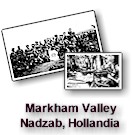

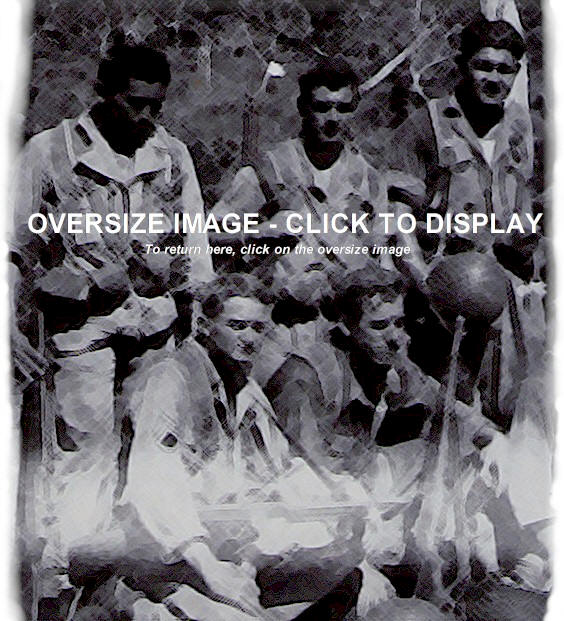
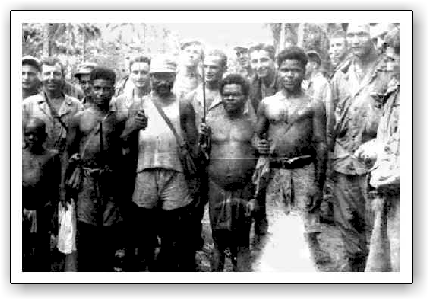
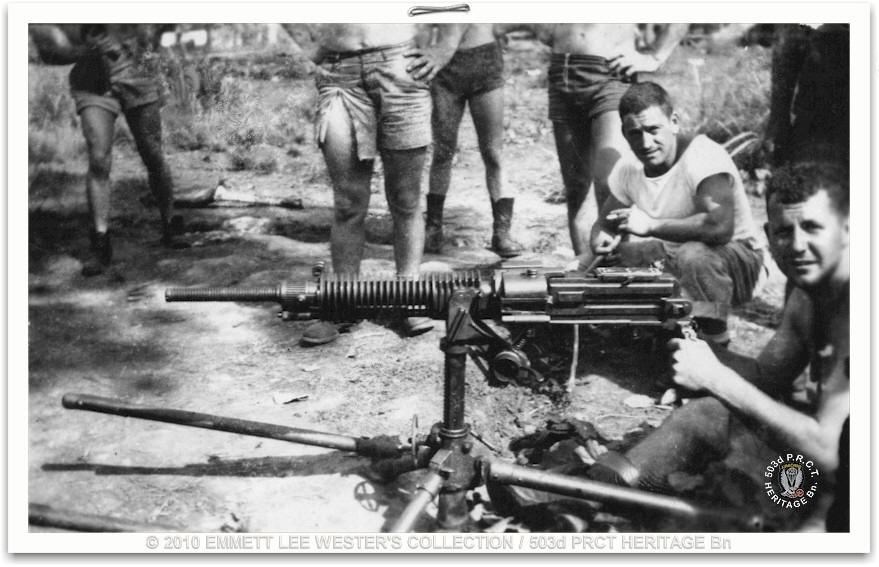
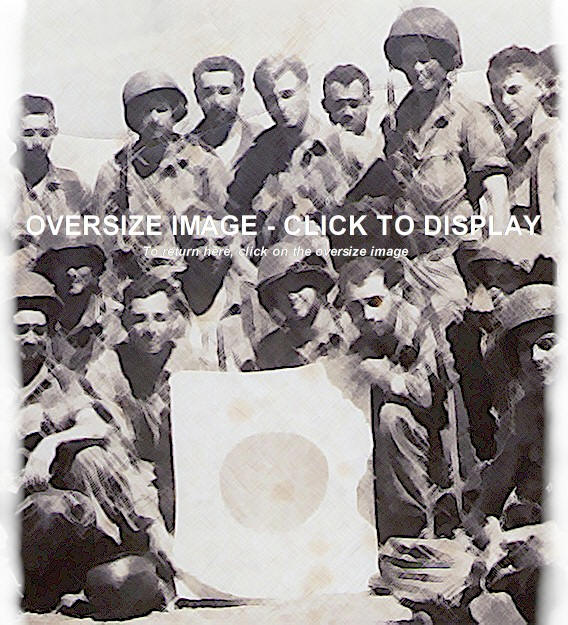
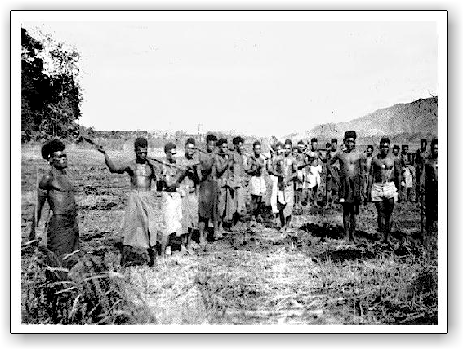
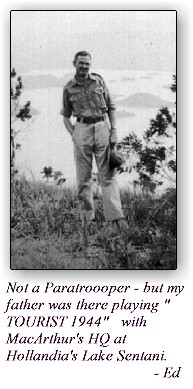 Having
completed our mission we moved into a large valley, probably one of the most
beautiful spots on Earth. Here we dug fox holes and set up a perimeter with the
yam field to our front and a Native village to our rear. The young Native boys
enjoyed spending their time with us, and showed us how to make shelters from
banana leaves to cover our fox holes and protect us from the rain. In the time
we spent with them, we taught them to speak a few words of English (�Hey
Joe�, etc.) and to sing �Pistol Packing Mama.� It was funny to hear them
sing. Their version came out �Peestola pawking mama, lie dots peestola
down.�
Having
completed our mission we moved into a large valley, probably one of the most
beautiful spots on Earth. Here we dug fox holes and set up a perimeter with the
yam field to our front and a Native village to our rear. The young Native boys
enjoyed spending their time with us, and showed us how to make shelters from
banana leaves to cover our fox holes and protect us from the rain. In the time
we spent with them, we taught them to speak a few words of English (�Hey
Joe�, etc.) and to sing �Pistol Packing Mama.� It was funny to hear them
sing. Their version came out �Peestola pawking mama, lie dots peestola
down.�
